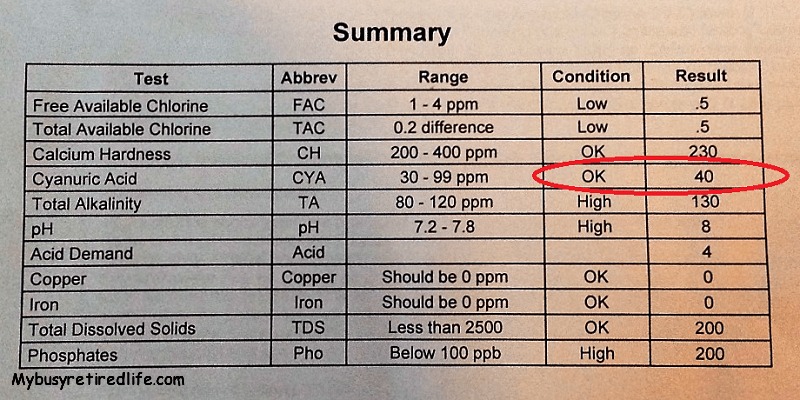Winter Months and CYA Levels
Winter months and CYA levels in the pool go hand in hand. It’s going into winter again and it’s time to start concentrating on lowering my CYA levels in my pool. This way, next May when the “Pool Season”, opens my CYA levels will be low enough to not worry about having to drain my pool.
One of the most common chemicals used for the prevention of chlorine loss in swimming pools is Cyanuric Acid (also called CYA, Conditioner, or Stabilizer); it protects the free chlorine from being destroyed by the sun ultraviolet rays.
– unknown, http://www.autopilot.com/blog/post/264-What-is-Cyanuric-Acid-and-How-Does-It-Affect-My-Swimming-Pool-Water-
So how am I going to lower my CYA levels?
I am going to keep my eyes open for opportunities to lower my CYA levels starting with the chlorine I use. I am going to switch from tablets to powdered chlorine calcium hypochlorite. This product is used because it has no stabilizer(cya) added. So for the winter months, I will not be adding any additional CYA to my pool water.
The use of Calcium Hypochlorite
Chlorine levels using calcium hypochlorite during the fall/winter months is very easy. This is because there is no high chlorine demand during this time frame.This makes the use of this product easy due to the cool weather. I use this product sparingly as I don’t want to get a High Calcium problem which is just as bad as high cya.
 Rain Water
Rain Water
My second opportunity is rainwater. Anytime it rains and raises the water level in the pool I have two opportunities either drain or backwash the sand filter. If I choose to drain the pool this helps to dilute the CYA levels in the pool. If I choose cleaning the sand filter it removes organics from the water, reduces the pool’s need for chlorine and dilutes the CYA levels in the pool.
Backwashing the pool, cleaning out the filter baskets, staying on top of leaves and organics blown into the pool reduces the organics that the pool water is exposed to and reduces the food available for the algae to feast on. Removal of this material makes the available chlorine in the pool water work less hard and makes using powdered chlorine much easier to control algae.

My CYA levels from last May
The above photo is from last May my CYA numbers are at 40 ppm. Going into the winter months my CYA levels were in the upper 90’s. Using the above procedure you can see how I was able to lower my numbers by 50 points. I plan on repeating these numbers again this winter.
Related Article: Hard Lessons Learned on Pool Water Chemistry
(Mybusyretiredlife.com All Rights Reserved)
(Mybusyretiredlife.com All Rights Reserved)
(Mybusyretiredlife.com All Rights Reserved)


 Rain Water
Rain Water